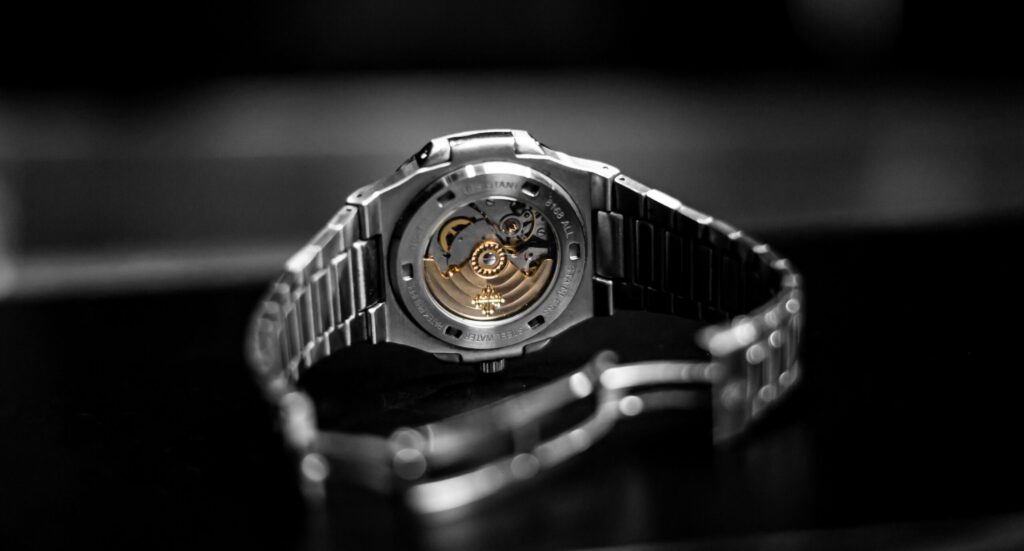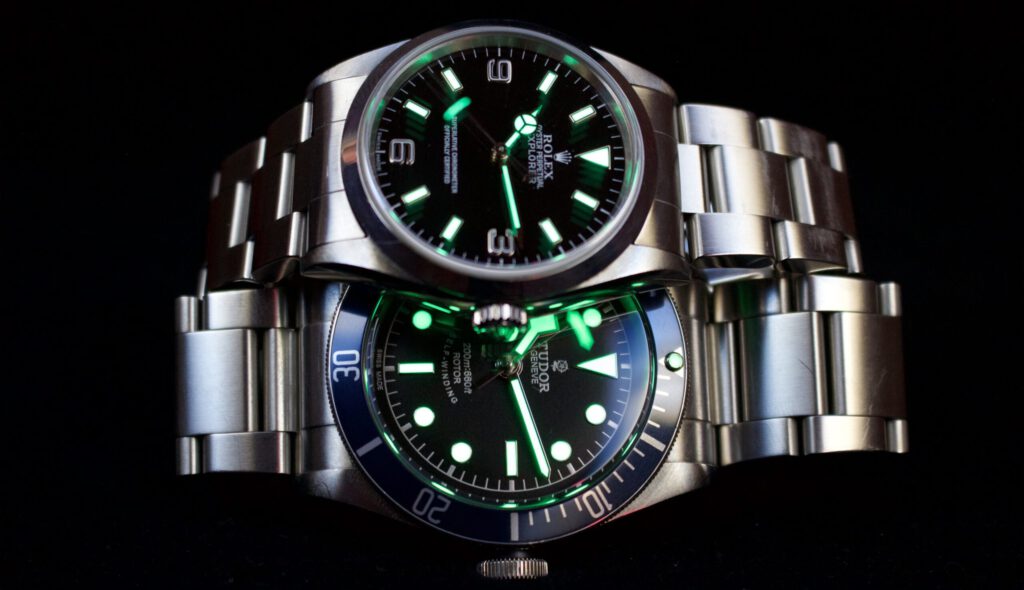
Many readers asked muula.ch to explain the hype surrounding Swiss luxury watches. So, we do just that with a guide to Rolex, Patek Philippe & Co.
Swiss luxury watches are far more than just precise timepieces.
They are an expression of craftsmanship, innovation and aesthetic excellence.
Tensioned springs as energy source
But a jungle has grown up around them, making it almost impossible for interested parties to navigate their way around.
In response to numerous reader requests, the business news portal muula.ch has therefore produced this handy guide into the world of luxury watches, even highlighting aspects that are the main criteria when buying or investing.
At the heart of every luxury watch is the movement. These movements can be either mechanical or quartz operated.
Second hand makes the difference
Quartz movements use a battery and a quartz crystal to measure the time. They are extremely precise and low-maintenance. It can be recognized directly by the second hand, which jumps abruptly from one number to the next.
However, most of the hype surrounding luxury watches revolves around mechanical movements, which receive their energy from the inside via a tensioned spring, interacting with a multitude of precisely manufactured components interlocking perfectly to display the time via multi-stage gears.
The second hand glides slowly from one value to the next.
Power reserve in hours
The energy for the spring can come from two sources. On the one hand, the owners must wind the movement manually and the watch then runs for two to three days using that stored energy released in a controlled manner.
This is referred to as the ‘power reserve’ and is expressed in hours.
On the other hand, many watch manufacturers have developed innovative automatic movements that are constantly wound by the wearer’s movements.
This rough division between quartz watches and mechanical timepieces, which in turn can be automatic or manually operated, separates the wheat from the chaff.
Watch lovers swear by mechanical movements only.
Eta, Sellita and Miyota
But not everything is the same. Well-known watch manufacturers develop innovative movements exclusively themselves.
Others buy them from suppliers such as Eta, Sellita or Miyota, which are significantly cheaper due to their large production volumes.
Some luxury watch manufacturers also help each other with movements or use third-party suppliers and refine them with their own nuances.
Accordingly, watch collectors almost always prefer brands that use their own movements. This rules out many manufacturers as collectors’ items right from the start.
Combinations possible
Based upon those movements, you can already see that there are two major watchmaking regions.
On the one hand, there is Switzerland, which is considered the epicenter of the luxury watch industry and where ETA and Sellita movements are manufactured.
On the other hand, Japanese watch manufacturers have also established themselves by combining traditional watchmaking with modern technology, such as from Miyota.
These movement manufacturers are often part of large conglomerates.
ETA, for example, is part of the Swatch Group and Miyota is a subsidiary of Citizen Watch from the city of the same name, Miyota, in Nagano Prefecture.
Cartier, IWC and Panerei
This brings those interested in luxury watches to the group affiliations. These give individual brands access to resources and global distribution networks. In Switzerland, the Swatch Group and the Richemont Group dominate the market.
Worldwide, the luxury goods group LVMH and Kering also play a role. In Japan, there is the Seiko Group as well as Citizen.
These groups have many brands for different customer groups in their portfolios.
Swatch covers practically the entire spectrum of demand with Tissot and Longines, ranging from the more affordable to the more upmarket Omega, Harry Winston, Breguet and Blancpain.
Family-owned companies
At Richemont, famous luxury watch brands include Cartier, IWC, Jaeger-LeCoultre, Vacheron Constantin, A. Lange & Söhne and Officine Panerai. These are all in the high-end segment.
LVMH produces TAG Heuer, Hublot and Zenith. LVMH is run by Bernard Arnault, who recently became the world’s richest man after overtaking Elon Musk and Jeff Bezos.
In addition to these group companies, there are numerous independent watch manufacturers. The most famous are probably Patek Philippe, Audemars Piguet and Rolex.

These are either family-owned or part of a foundation.
Numerous other watch manufacturers, such as H. Moser & Cie, Richard Mille, Jacob & Co, Ulysse Nardin, Girard-Perregaux and Oris, are in the hands of private individuals.
Luxury brands jump on bandwagon
Some timepiece enthusiasts rely exclusively on independent watch brands for their collections. In this respect, group companies are left behind, regardless of what they bring to the market.
In addition, other luxury design brands such as Gucci, Dior, Bulgari, Louis Vuitton, Hermes & Co. are jumping on the bandwagon with products from the watch world, which are usually only manufactured under license and therefore often do not represent collector’s items.
Sapphire crystals convincing
This brings us to the products. The watch industry has three main types of glass.
Acrylic glass is light and inexpensive. However, it is very susceptible to scratching. This is why it is only used in the lower price segment, if at all.
Then there is mineral glass. It is harder and more resistant to scratches.
At the top end there is sapphire crystal, which is extremely scratch-resistant and durable, is used almost exclusively in collectible luxury watches.
Gadgets galore
In addition to the time, watch manufacturers are focusing on more and more sophistication, depending on the target group. Decades ago, for example, pilots loved mechanical watches because they could display two time zones.
The additional functions that a watch offers over and above simple timekeeping, often referred to as complications, include chronographs that can measure certain time intervals using stopwatch functions.
Handy if you’re an F1 driver or Olympic athlete.

There are also perpetual calendars, which display the date, day, month and year, taking leap years into account. There are virtually no limits to their sophistication.
Tourbillons are mechanisms that minimize the influence of gravity on the rate and accuracy.
And experts define minute repeaters as functions that indicate the time using acoustic signals.
Waterproof and water-repellent
The more ‘gimmicks’ you can find on a luxury watch, the more enthusiasm it generates among fans.
In addition, there is water resistance, so that they can be worn while swimming or diving, or straps made of leather, rubber, nylon or metal, which offer various design and comfort features.
Naturally, leather is not an option for diving watches.
Rubies in the movement
For certain connoisseurs, such as Arabs, luxury watches have to be large and made of precious metals such as gold or platinum in order to be considered a status symbol.
Watch manufacturers also produce luxury watches with precious stones such as diamonds and the like.
Rubies are used as so-called ‘bearing jewels’ in the movement because they are very hard and can therefore perfectly cushion the movements in mechanical watches without wearing out.
The more complications a timepiece contains, the more stabilizing rubies or gemstones it requires.
Extravagant dials and bezels
Manufacturers of luxury Swiss watches are now playing with combinations across the board. All-gold versions alternate with reissues of models that have not been produced for decades.
Sometimes the crown, i.e. the wheel for setting and winding, is at four o’clock instead of three, or even on the opposite side. Sometimes the watches are ostentatious for top managers, sometimes they are fine for thin wrists.
The dial can be exclusive, sometimes the bezel, i.e. the edge of the watch glass, becomes something special.
Demand outstrips supply
Manufacturers are very careful to ensure that demand is always greater than supply so that sales prices never plummet.
They often leave interested parties in suspense, produce only ‘limited editions’ or simply offer the market models that are less in demand.
Rolex alone produces around one million pieces a year.
However, top luxury watch manufacturers prefer serious collectors as buyers, because their watches generally do not end up on secondary markets and virtually disappear from the scene.
Recognizing Frankenstein watches
However, there are many charlatans on the secondary markets who sell either complete fakes or hybrid watches that have been assembled from both original and fake parts and are referred to as ‘Frankenstein’ watches.
Gangs of counterfeiters create several fake watches from just one Rolex, making it very difficult to determine the authenticity.
Combination of identifying marks
Luxury watch manufacturers therefore have to come up with more and more features to identify their original handcrafted pieces, because the counterfeiting industry never sleeps.
Furthermore, there is no such thing as “the” distinguishing mark; it is usually the overall impression of workmanship, precession and so on.
This is also the reason why collectors prefer to wait years or sometimes even decades for a luxury watch from their preferred manufacturer.
Then, and only then, can watch fans be 100 percent sure that they are actually dealing with an original Swiss watchmaker’s art and not get lost in the complex jungle of luxury watches.
16.06.2024/kut./ena.





